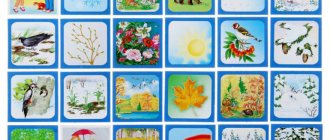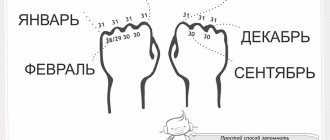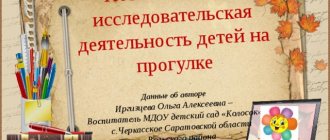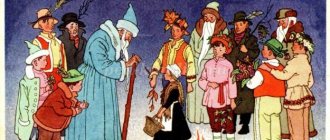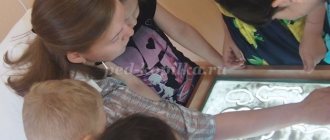Galaova Zalina Yurievna
Didactic games on the theme “Seasons”
Didactic games for the “Pyramid”
Didactic game “Complete”
(For children 4-7 years old)
A subgroup of children of 3-4 people participates in the game.
Goal: To consolidate children’s knowledge about seasonal changes in nature, supplement them with individual elements according to the seasons .
Material for the game: model “ Seasons ”
, card index of poems and riddles according to
the seasons , handouts for the game for each child.
Preparing educational materials
Young children perceive visual information best.
Therefore, before you start studying, take care of the didactic materials. These could be books, cards with the seasons, lotto. Your task is to explain to your baby in simple language, using his imagination and creating simple associations, what winter, spring, summer and autumn are. Advice:
It’s best to start with the season that is now outside the window. Or from winter, because for kids this is the most unusual time of the year.
Visual game: seasons
Take four sheets of paper, preferably in different colors: white for winter, blue for spring, green for summer and yellow for autumn. An adult draws a tree with branches on each sheet. And then you need to transform each tree together with your baby, according to the seasons.
The winter one will be covered with a layer of white cotton wool or semolina like snow. In the spring, small green dotted leaves will appear, drawn with a cotton swab. The summer one will have large green leaves and flowers, which can be made from pre-dyed pasta or cut out from construction paper. Fall can be decorated with bright buttons or bright red and orange brush blots.
Advice:
First of all, you need to draw the child’s attention to how this or that season differs from another.
Winter.
It's cold, it's snowing. You can sled, ski and skate, and also make snowmen and play snowballs. We dress in warm clothes, wear mittens and hats with scarves. And in winter the New Year comes, and Grandfather Frost gives us gifts.
Spring.
Snow is melting. It is getting warmer. You can put your fur coat and mittens in the closet and put on a light jacket. The birds are returning. The first leaves and grass appear.
Summer.
It is hot outside. Everything is green, lots of flowers. We eat fruits and berries, swim and sunbathe. Everyone rides scooters and bicycles.
Autumn.
The leaves are turning yellow. The birds are flying away. It's getting cold and it's starting to rain. You need umbrellas, raincoats, rubber boots.
It is very convenient to teach the seasons, “starting” from the baby’s wardrobe. Together, put together a set of clothes to go outside in winter or summer. You can use dress-up games: paper dolls that change clothes (they can be magnetic or with Velcro).
When the first stage is mastered, it will be possible to tell in detail what is happening to nature, to water, what animals are doing. Get ready to answer a hundred thousand questions. A colorful children's encyclopedia will help you.
After you have talked about everything, it’s time to consolidate the material, and here you can’t do without games. For example, you can sort cards with pictures by season, or name what people do in the fall and what in the spring.
You can prepare 4 small boxes, decorate them beautifully and, together with your baby, fill the boxes with “memories” of summer, autumn, winter and spring. Sort out your family photo archive and make a “calendar” of photos. The baby will see how he himself looked in the fall and spring, what he was wearing and what he did outside in winter and summer.
Draw your child’s attention to changes outside the window more often. Explain that it can rain in summer, and that the sun shines in winter, but it does not warm. Tell your child as much as possible about the world around him and answer all his questions, and then soon he will not confuse winter with spring, and summer with autumn. And after a little more time he will be able to list all the months of the year, and in the correct order!
Advice:
It makes sense to teach your child the months of the year no earlier than 4-4.5 years. Of course, it’s difficult for kids to understand a month as a period of time, so at first it will just be encyclopedic knowledge.
One of the most effective ways to learn about the seasons is to associate each of them with a holiday. So, winter is New Year, spring is March 8, summer is vacation, autumn is Knowledge Day. And it will be easy for the child to remember the season and month when his birthday is celebrated.
Introducing children to the seasons
Introducing preschoolers to the seasons
It is very important to introduce children to the seasons, because little ones are very curious from birth.
She is very interested in everything that happens around her, for example, when it snows outside, she does not understand what it is and where it comes from and whether it is dangerous.
It is very good to familiarize children with the seasons, for example winter, with a clear example; when there is snow outside, there are patterns on the windows. If winter is already coming, but there is no snow yet, then you can use pictures, videos, and make a projection.
It is important for a child to understand from an early age what Winter, Summer, Spring, Autumn are.
The seasons sometimes imperceptibly and slowly smoothly replace each other, giving each season its own characteristic color. By introducing children to seasonal changes in nature, we teach them to observe the weather and natural phenomena that occur throughout the year.
For children, the seasons look like a new world each time with bright, characteristic colors, smells and sensations inherent in a certain time of year. You can start introducing children to the seasons with pictures describing nature, demonstrating the features of the season, and introduce easy poems about nature for children about the seasons in pictures and riddles.
So, let's look at what seasons of the year and how best to introduce children to seasonal weather changes:
In autumn, it is necessary to observe the weather conditions every day. So that the kids can focus their attention on the air temperature, you can invite them to dress the doll themselves for a walk. At this moment, it is imperative to talk to the kids and ask why he takes this or that clothing. When the air temperature drops in the fall, you need to pay children's attention to how they are dressed. When walking, they should be invited to touch the cold wall of the house or a bench. On those days when the sun shines brightly, and then the clouds quickly cover it, you can ask the kids why it became dark or brighter. In addition, you need to concentrate children's attention on changes in wind movement. To do this, you can take paper ribbons and special toys – pinwheels – for a walk. Also, in the fall it is good to observe the rain with children. Kids can watch puddles appear on the asphalt and listen to the rain knocking on the windows.
For good reinforcement, you can invite the children to listen to poems, riddles, try to guess a puzzle about this time of year and, if desired, learn a short poem and tell it to all the children at the next lesson.
Stocks have been made The leaves are flying around First sister - golden AUTUMN
- In winter, it is necessary to show children weather changes in various ways. You can again take the doll and dress it with the kids together. At the same time, constantly reminding you that it is bitterly cold outside. During a walk, you can invite the children to take off their mittens for a few minutes so that they can feel the cold. Also, it is necessary to draw their attention to how people passing by are dressed. If snow falls, then you definitely need to tell and show the kids how much there is on the ground, on the benches, on the trees and on the fence.
Snow sparkles everywhere -
The Second Sister herself came to us - Zimushka - WINTER
- In spring, you need to more often pay children’s attention to how brightly the sun is shining, and watch the sun’s rays with them. You can organize small games using water, during which you can show the kids how it flows.
Birds arrive Animals wake up The third sister is called SPRING
- In the summer, you need to help children understand weather changes using questions. For example, ask why the stone is hot now, but was cold in winter? Also, it is necessary to observe the wind, drawing the kids’ attention to the trembling and noise of leaves on the trees.
Everyone is fed, warmed by the bright light of the sun. The fourth sister is called SUMMER.
Observations should take place gradually and be connected; this is the only way to create a system of skills, knowledge and abilities in preschoolers.
Preparation for observation:
- Select an object for observation, study its properties well;
- Determine the main purpose of observation, draw up a clear plan;
Observations should take place gradually and be connected; this is the only way to create a system of skills, knowledge and abilities in preschoolers.
Preparation for observation:
- Select an object for observation, study its properties well;
- Determine the main purpose of observation, draw up a clear plan;
Preparation for observation:
- Select an object for observation, study its properties well;
- Determine the main purpose of observation, draw up a clear plan;
- Conduct a preliminary conversation with the children. Children should understand what they will observe and for what purpose. For example, the teacher tells the children that on the excursion they will observe how nature has changed with the onset of autumn;
- Outline questions for conversation accompanying children's observations;
- Determine the amount of work to enrich and activate children’s vocabulary and develop individual lexical tasks taking into account the emotional and personal characteristics and communication skills of each child.
Observation is designed to stimulate children's cognitive activity and arouse genuine interest in every child. For example, children are given the task of collecting fallen leaves. P The teacher can play the game “Who will collect the largest (smallest) leaves of chestnut (oak, maple, etc.)?”, Ask them to come up with a short story on the topic “What did I like about the autumn forest?”
During observation, preschool children’s vocabulary should be enriched, activated, new words should be used in independent speech, and they should be consolidated in memory. To do this, children need to ask questions, focusing on words that are new to them, stimulating the use of new words or familiar words in a new meaning for them. When clarifying children’s statements, the teacher must monitor the use of definitions denoting the characteristics of objects or phenomena, as well as the correct grammatical format of speech. The children's attention is drawn to the signs characteristic of this or that time of year, sayings and poems are memorized. At the end of the observation, it is necessary to summarize what the children learned during it.
Bibliography
- METHODOLOGY FOR FAMILIARIZING PRESCHOOL CHILDREN WITH NATURE PHENOMENA (electronic resource) // Website “Structural unit No. 152” - https://ds152.centerstart.ru/node/176
- Methodology for introducing preschool children to the seasons in the form of KVN while staying in a children's sanatorium (electronic resource) // Website “ALL-RUSSIAN INTERNET COMPETITION OF PEDAGOGICAL EXCELLENCE” - https://educontest.net/component/content/article/51-1 /29251-2013-07-02-09-40-28.html
- Familiarization of preschool children with the seasons (course work) (electronic resource) // Website “Diploma - Easy” - https://www.diplom-legko.ru/download/free-author/pedagogika-author/oddwswgkr.html
- Seasons for children in poems and pictures (electronic resource) // Website “Seasons of the Year” - https://xn—-8sbiecm6bhdx8i.xn--p1ai/%D0%B2%D1%80%D0%B5%D0%BC %D0%B5%D0%BD%D0%B0%20%D0%B3%D0%BE%D0%B4%D0%B0%20%D0%B4%D0%BB%D1%8F%20%D0%B4 %D0%B5%D1%82%D0%B5%D0%B9.html
Books about the seasons
- Series “Town” by Susanne Rotraut Berner. Spring, Winter, Summer, Autumn. These are books without words. You look at them and come up with stories yourself. There are a lot of characters in the pictures, which are very interesting to look for and not always easy to find.
- “Titmouse Calendar” by Bianchi.
- Vladimir Svechnikov “Seasons. Illustrated Encyclopedia".
- Elena Ulyeva “Creative tasks. Seasons".
- Tatyana Romanova “We play in the seasons. 40 savvy ideas for kids."
- S. Marshak “All year round.”
- Alexander Golubev “Summer Adventures of Klevik” (there is a book about winter, spring and autumn).
About the seasons for younger schoolchildren (7-11 years old)
About the seasons in poems for primary school students
Introductory “tour” for children with poems and games in pictures.
Author: Shevchenko Svetlana Alekseevna, teacher of the State Educational Institution of the Republic of Kazakhstan, boarding school of the VIII type, Orlovsky village. Purpose: The development will be useful for teachers, children, and parents. Goal: conducting a virtual tour for children through the seasons with games and poems. Objectives: - introduce children to poetry about the seasons; - develop observation and speech skills; — expand your horizons; — to cultivate a love for the nature of the native land.
Progress of the lesson. Educator: Hello, guys! Today we are going on an excursion through the seasons, but not a simple one, but a virtual one. What seasons do you know? Children's answers. Educator: Well done, you know all the seasons, and now listen to the poems that the guys learned for our lesson. Children read poetry:
G. Osmanova There lived an old grandfather in the world, His grandfather's name was YEAR, On earth he ruled the firmament for many years. In the morning the sun woke up, And raised his daughters in goodness and peace, There were four of them. They lived as a friendly family, respected their elders, walked one after another along the earth. The first sister - WINTER Gently covered all the paths and houses with a blanket of snow. And behind her came SPRING, seething like a stream, she gave new leaves to the twigs. Lifted the sleepy forest with a ringing drop, Noisy fun echoed to the skies. After SUMMER came in a dress with cornflowers, beckoning to the warm sea, on sultry days. She called butterflies to dance, Sang with nightingales, Next to her everything bloomed with bright flowers. AUTUMN was the youngest And my beloved daughter, I took bright brushes, I painted leaves, I collected the harvest, I saw off the birds, And with the rains I accidentally shed Tears... On earth their round dance Lasts endlessly... The days flew by, with them the YEAR flew by like a bird.
Educator: Now let’s play the game “Labyrinth”. Game "Labyrinth". Walk along the paths of the labyrinth and you will find out at what time of year the bear sleeps, when the strawberries ripen in the forest and when the birds fly to warmer climes and others; the questions can be varied, depending on the selection of pictures.
Educator: Well done, guys! Our excursion continues and we set off to visit winter. Children read poems: About winter (V. Fetisov) Fluffy, silver snow spreads like a light carpet, And snowflakes, like feathers, curl merrily around. Snowball (N. Nekrasov) The snowball is fluttering and spinning, It’s white outside. And the puddles turned into cold glass. Where the finches sang in the summer, Look today! - Like pink apples, there are bullfinches on the branches. The snow is cut up by skis, Like chalk, creaky and dry, And the red cat catches cheerful white flies. Snowflakes (I. Bursov) Light, winged, like moths, whirling and whirling Above the table by the light bulb. We gathered for the fire. Where should they go? After all, they, too, icy, want to warm up.
Educator: Let's play the next game, it will be logical. Game "Fourth wheel". From the group of proposed pictures, choose the odd one. Explain your choice.
Educator: we are going to visit the next time of year - spring.
Children read poems about spring. Spring (B. Elshansky). The snow got wet and the ice began to cry - Winter will end soon. From dawn to dusk the miracle tower melts. Nature wakes up - Like a birch tree blossoms. Only Grandfather Frost's business doesn't go well in the spring Snowdrop (P. Solovyova) In the forest, where the birch trees crowded together, Snowdrop's blue eye peeked. First, Green put out his leg a little, Then he stretched with all his scarlet strength And quietly asked: “I see the weather is warm and clear, Tell me, is it true that this is spring?” Freckles (V. Orlov) Spring passed along the edge of the forest, Through the blue dreams of spring, And the freckles quietly shone on the face of the girl of spring. A girl walked in a green skirt, ringing with the blue dew. And, envying the red-haired girl, the earth sighed imperceptibly. And it’s not in vain that on this spring morning, where the light legs passed, dandelions bloomed, Like the golden freckles of the earth. Educator: I suggest you guess riddles about spring. (Selection of riddles). *** The beauty walks, touches the ground lightly, goes to the field, to the river, and over the snow and over the flower. (Spring) *** I was the first to crawl out of the earth on a thawed patch. He is not afraid of frost, even though he is small. (Snowdrop) *** In a blue shirt Runs along the bottom of the ravine. (Stream) *** Not a pedestrian, but walking. People at the gates are getting wet. The janitor catches him in a tub. A very difficult riddle? (Rain) *** White peas On a green stem. (Lily of the valley) *** With an inaudible rustle of petals, snow-white pearls blossomed, A fresh, delicate tiny Flower From under the snow rushed towards the sun. (Snowdrop) *** Yellow, fluffy, fragrant balls. They will be protected from the frost in their branches... (Mimosa) *** The snow is turning black in the clearing, The weather is getting warmer every day. Time to put the sled in the closet. What a time of year it is. (Spring) Educator: The next time of year is summer.
Children read poems: Happy summer (V. Berestov) Summer, summer has come to us! It became dry and warm. Barefoot feet walk straight along the path. The bees are circling, the birds are flying, and Marinka is having fun. I saw a rooster: “What a miracle!” Ha ha ha! Amazing rooster: Feathers on top, fluff below! I saw a piglet, the girl smiled: - Who runs from a chicken, squeals all over the street, Instead of a tail there is a hook, Instead of a nose there is a snout, Piglet is full of holes, And the hook is squirmy? And Barbos, the Red Dog, made her laugh to tears. He is not running after the cat, but after his own tail. The cunning tail curls, it doesn’t get into your teeth. The dog waddles sadly, Because he is tired. The tail wags cheerfully: “I didn’t get it!” I didn’t get it!” Summer, summer has come to us! It became dry and warm. Barefoot feet walk straight along the path.
Dandelion (O. Vygotskaya) The sun dropped a golden ray. The first dandelion grew up, young. It has a wonderful golden color. He is a big sun Small portrait.
Summer (Ya. Akim) If there are thunderstorms in the sky, If the grass has blossomed, If early in the morning the dew Bends the blades of grass to the ground, If in the groves above the viburnum there is a hum of bees until the night, If the sun has warmed all the water in the river to the bottom - So this is already summer! So spring is over! Physical exercise. Flowers grow in the meadow Flowers grow in the meadow Of unprecedented beauty. (Stretching - arms to the sides.) Flowers are reaching towards the sun. Stretch with them too. (Stretching - hands up.) The wind blows sometimes, But it’s not a problem. (Children wave their hands, imitating the wind.) The flowers bend down and lower their petals. (Bends over.) And then they get up again And still bloom. Educator: Well done, guys! We had a good rest, and now we are going to visit the next time of year.
Children read poems about autumn. Autumn (V. Avdienko) Autumn walks along the path, Her feet are wet in the puddles. It's raining and there's no light. Summer is lost somewhere. Autumn is walking, Autumn is wandering. The wind threw the leaves off the maple tree. Underfoot there is a new rug, Yellow-pink - Maple. Autumn song (A. Pleshcheev) Summer has passed, Autumn has come. The fields and groves are empty and sad. The birds have flown away, the days have become shorter, the sun is not visible, the nights are dark, dark. Leaf fall (E. Avdienko) The leaves have fallen off the maple tree, The maple tree is trembling from the cold. There is a golden carpet on the path near the balcony. Educator: Now watch the dramatization that the guys prepared based on V. Orlov’s poem “Autumn Tasks.” Dramatization: In the morning, in the forest, spiders—telephone operators—are fussing over a silver thread. And now, from the Christmas tree to the aspen tree, cobwebs sparkle like wires. The bells are ringing: - Attention! Attention! Listen to the fall assignments! - Hello, bear! - I'm listening to! Yes Yes! - Cold weather is just around the corner! Before winter approaches, you urgently need to find a den! The bells of squirrels and hedgehogs are ringing, From the upper to the lower floors: - Check your pantries as soon as possible - Are there enough supplies for wintering? Bells are ringing near the old swamp: “Are the herons all ready to fly away?” - Everything is ready for departure! - Good luck! Don't forget to stop by again! The bells ring at the linden and maple trees: - Hello! Tell me, who's on the phone? - Hello! Ants are on the phone! - Close your anthills! - Tell me, is this a river? - River, river! - Why isn’t there a place for crayfish? And the river answers: “They’re lies!” I'll show you where crayfish spend the winter! - Hello, guys! Good afternoon guys! It's already a little cold outside! It's time for birds to hang out feeders - on windows, on balconies, at the edge of the forest! After all, birds are your faithful friends, And we must not forget about friends! Educator: Clap our artists! Notice how beautifully our hall is decorated, here is an exhibition of books, and here is an exhibition of drawings about the seasons, you all tried. This is the kind of sightseeing “tour” we had through the seasons. And I want to end our excursion with the poems of Sergei Mikhalkov. “All year round” Winter comes inadvertently, taking its toll on all counts. It should be there by the deadline, but, come on, it’s not there! And suddenly, one day, early in the morning, I looked out the window glass and you see a “self-assembled tablecloth” - Everywhere, around, white and white... Spring comes gradually: The snow is silently melting in the fields, Escape from the icy captivity The river waters are secretly preparing. The frosts at night are not the same, and now the starling is flying to his house on the birch trunk... Spring has come. Winter is over! And after Spring comes Summer, after Summer comes Autumn in turn, and again Winter. And again somewhere Spring is in a hurry to go on a hike. Educator: Thank you all for your attention and activity, see you again!
We recommend watching:
Summer. Folk signs, calendar for children 5-7 years old About summer for kindergarten children 5-7 years old Summary of GCD in the senior group on the topic: Summer Poems about summer for preschoolers
Similar articles:
Interesting facts about vegetables for children
Everything about the month of June for children
Orthodox summer holidays and folk signs for preschoolers
Everything about the month of July for children
Everything about the month of August for children
